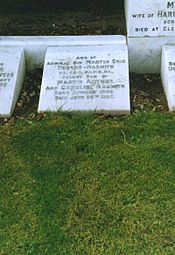- Martin Dunbar-Nasmith
-
Sir Martin Eric Dunbar-Nasmith 
Martin Eric NasmithBorn April 1, 1883
Barnes, London, EnglandDied June 29, 1965 (aged 82)
Elgin, Moray, ScotlandBuried at Elgin Cemetery, Linkwood Road, New Elgin, Elgin Allegiance  United Kingdom
United KingdomService/branch  Royal Navy
Royal NavyYears of service 1898 - 1946 Rank Admiral Commands held East Indies Station (1932-1935)
Vice-Admiral of the United Kingdom (1954-1962)
Plymouth Command (1938-1941)
Western Approaches Command (1939-1941)
Flag Officer-In-Charge, London (1942-1945)Battles/wars Awards Victoria Cross
Knight Commander of the Order of the Bath
Knight Commander of the Order of St Michael and St George
The Royal Norwegian Order of St. Olav
Polonia Restituta (Poland)
Legion of Honour (France)
Order of Orange Nassau (Netherlands)
Croix de Guerre (France)
Cross of Liberty II/2 (Estonia)Relations Sir James Dunbar-Nasmith (son)
Rear Admiral David Dunbar-Nasmith (son)Other work Vice Chairman, Imperial War Graves Commission (1948-1954)
Deputy Lieutenant and Vice-Lord Lieutenant, MorayshireAdmiral Sir Martin Eric Dunbar-Nasmith VC, KCB, KCMG, RN (1 April 1883 – 29 June 1965), was an English recipient of the Victoria Cross, the highest and most prestigious award for gallantry in the face of the enemy that can be awarded to British and Commonwealth forces. He was born Martin Eric Nasmith, adding the "Dunbar" part of his name after World War I.
Contents
Early career
Educated at Eastman's College in Winchester and the Royal Naval College, Dartmouth, Dunbar-Nasmith joined the Royal Navy in 1898.[1]
World War I
He was 32 years old, and a Lieutenant-Commander in the Royal Navy during World War I, when the following deed took place for which he was awarded the VC.[2]
During the period 20 May–8 June 1915 in the Sea of Marmara, Dardanelles, Turkey, Lieutenant-Commander Nasmith, in command of H.M. Submarine E.11, destroyed one large Turkish gunboat, two transports, one ammunition ship, three store ships and four other vessels including civilian transports and torpedo boats which trying to save drowning men and women of E11's targets. Nasmith and HMS E11 also tried to destroy a Kızılay (Red Cross of Ottoman Empire) Hospital Ship which carrying 700 wounded soldiers from battlefields, but failed.When he had safely passed the most difficult part of his homeward journey he received information that a cargo of coal was heading towards Istanbul from the Black Sea. Realising that coal was essential for the morale of the besieged city, Nasmith turned back.
When the coal-carrying ship came into sight of the docks, a welcoming committee of municipal grandees soon formed, along with a happy crowd - water, electricity and rail transport had all suffered due to a lack of coal. Hardly had the ship berthed than it mysteriously blew up before the eyes of the astounded crowd. Nasmith successfully slipped out again.He was appointed Commandant of the Royal Naval College Dartmouth in 1926 and then became Rear Admiral Submarines in 1929.[2] He became Commander-in-Chief of the East Indies Station in 1932 and Second Sea Lord and Chief of Naval Personnel in 1935.[2] He was Commander-in-Chief, Plymouth from 1938 and then Commander-in-Chief of Plymouth and Western Approaches Command from the outbreak of war in September 1939.[2] He served as Flag Officer in charge of London from 1942 and retired in 1946.[2]
In retirement he became Vice Chairman of the Imperial War Graves Commission .[2] He was also appointed Vice-Admiral of the United Kingdom, a ceremonial position, and he became President of the Royal Naval Benevolent Trust.
Family
In 1920 he married Beatrix Justina Dunbar-Rivers; they had two sons (Rear-Admiral David Dunbar-Nasmith and the architect Professor Sir James Dunbar-Nasmith) and a daughter.[1]
References
- Monuments to Courage (David Harvey, 1999)
- The Register of the Victoria Cross (This England, 1997)
- VCs of the First World War - Gallipoli (Stephen Snelling, 1995)
- VCs of the First World War - The Naval VCs (Stephen Snelling, 2002)
- Dardanelles Patrol: the Story of Submarine E-11 (Peter Shankland & Anthony Hunter, 1964)
External links
Military offices Preceded by
Sir Eric FullertonCommander-in-Chief, East Indies Station
1932–1934Succeeded by
Sir Forrester RosePreceded by
Sir Dudley PoundSecond Sea Lord
1935–1938Succeeded by
Sir Charles LittlePreceded by
Sir Reginald PlunkettCommander-in-Chief, Plymouth
1938–1941Succeeded by
Sir Charles ForbesHonorary titles Preceded by
Sir Montague BrowningVice-Admiral of the United Kingdom
1945–1962Succeeded by
Sir John EdelstenCategories:- 1883 births
- 1965 deaths
- British Gallipoli Campaign recipients of the Victoria Cross
- Royal Navy World War II admirals
- Royal Navy submarine commanders
- Knights Commander of the Order of the Bath
- Knights Commander of the Order of St Michael and St George
- Grand Officiers of the Légion d'honneur
- Lords of the Admiralty
- Recipients of the Order of Polonia Restituta
- Royal Navy recipients of the Victoria Cross
- People from Barnes, London
- Royal Navy officers of World War I
- Deputy Lieutenants of Moray
- Recipients of the Order of Orange-Nassau
- Knights Grand Cross of the Order of St. Olav
- Recipients of the Croix de Guerre (France)
Wikimedia Foundation. 2010.

